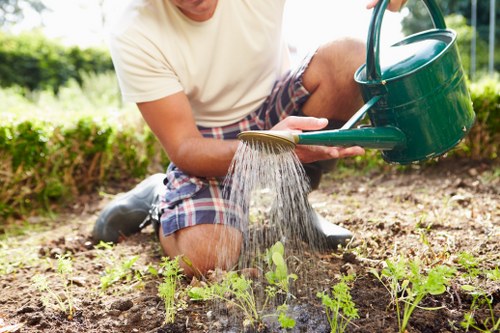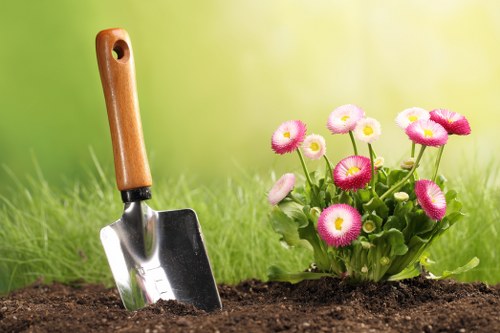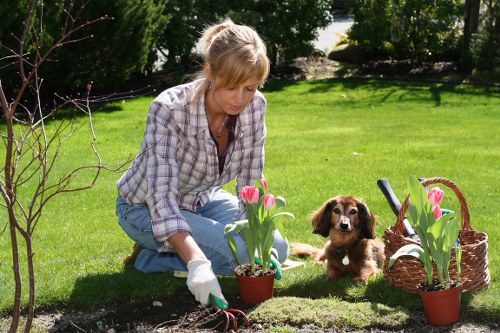Mastering Landscape Gardening through Expert Hedge Trimming

The Importance of Hedge Trimming in Landscape Gardening
Hedge trimming is a fundamental aspect of landscape gardening, playing a crucial role in maintaining the health and aesthetic appeal of your outdoor spaces. Regular trimming ensures that hedges remain well-shaped, vigorous, and free from diseases.
Properly trimmed hedges can serve as effective boundaries, reducing noise, providing privacy, and enhancing the overall structure of your garden. They also contribute to the microclimate of your garden by providing shade and shelter to other plants.
Incorporating hedge trimming into your gardening routine can significantly boost the visual appeal of your landscape, making it more inviting and well-maintained.

Techniques for Effective Hedge Trimming
Successful hedge trimming requires a combination of the right tools, techniques, and timing. Understanding the specific needs of your hedge type is essential for achieving the best results.
One common technique is shearing, which involves using hedge shears to create a flat, even surface. This method is ideal for formal hedges and topiaries, where precision is paramount.
Another technique is sculpting, which allows for more creative and natural shapes. This approach is suitable for informal gardens where a more relaxed appearance is desired.

Choosing the Right Tools for Hedge Trimming
Investing in high-quality tools is essential for effective hedge trimming. The following tools are indispensable for any gardener:
- Hedge Shears: Ideal for creating clean, even cuts on smaller hedges.
- Pruning Saws: Perfect for thicker branches that shears cannot handle.
- Loppers: Provide leverage to trim larger stems and branches.
- Electric Trimmers: Offer efficiency and ease for extensive trimming jobs.
Maintaining your tools by keeping them sharp and clean will ensure longevity and better performance during trimming sessions.

Best Practices for Hedge Maintenance
Maintaining hedges goes beyond regular trimming. Implementing best practices ensures that your hedges stay healthy and vibrant.
Watering: Ensure your hedges receive adequate water, especially during dry periods. Deep watering encourages strong root growth.
Fertilizing: Apply appropriate fertilizers to provide essential nutrients that support growth and resilience against pests.
Pest Control: Regularly inspect your hedges for signs of pests or diseases and take prompt action to mitigate any issues.

Seasonal Considerations in Hedge Trimming
Different seasons require different approaches to hedge trimming. Timing your trimming activities appropriately can enhance the health and appearance of your hedges.
Spring: Focus on shaping and controlling growth as new shoots emerge.
Summer: Maintain the desired shape and remove any dead or damaged branches.
Autumn: Prepare your hedges for winter by performing a final trim to prevent damage from snow and ice.
Winter: While active growth slows, you can still perform light trims to maintain appearance.
Integrating Hedge Trimming into Your Garden Design
Hedge trimming should be aligned with your overall garden design to create a harmonious and cohesive outdoor space. Consider the following when integrating trimmed hedges:
- Symmetry and Balance: Trim hedges to complement the symmetry of your garden layout.
- Focal Points: Use well-trimmed hedges to highlight key areas or features in your garden.
- Functionality: Ensure that hedges serve practical purposes such as providing privacy or defining pathways.
- Variety: Incorporate different hedge types and trimming styles to add depth and interest.
Thoughtful integration of hedge trimming enhances both the functionality and beauty of your garden.
Common Mistakes to Avoid in Hedge Trimming
Avoiding common mistakes can significantly improve the outcome of your hedge trimming efforts:
- Over-Trimming: Cutting too much can stress the plant and encourage weak growth.
- Improper Timing: Trimming at the wrong time of year can disrupt the plant's natural cycles.
- Using Dull Tools: Dull blades can cause ragged cuts, making hedges more susceptible to disease.
- Ignoring Plant Health: Trimming sick or damaged plants without addressing underlying issues can worsen their condition.
Being aware of these pitfalls ensures healthier and more visually appealing hedges.

Expert Tips for Professional-Looking Hedges
Achieving professional-looking hedges is attainable with a few expert strategies:
Consistency: Trim your hedges regularly to maintain a uniform shape and size.
Clean Lines: Aim for sharp, clean cuts to enhance the formal appearance of your hedges.
Attention to Detail: Focus on small sections and intricate areas to ensure overall precision.
Proper Lighting: Ensure there is adequate lighting around your hedges to highlight their shape and details.
Enhancing Biodiversity with Hedgerows
Hedgerows are not only aesthetically pleasing but also vital for promoting biodiversity in your garden. Well-maintained hedges provide habitat and food sources for a variety of wildlife, including birds, insects, and small mammals.
Incorporate diverse plant species within your hedges to support different types of fauna and enhance the ecological balance of your garden.
By fostering a biodiverse environment, your hedges contribute to the overall health and resilience of your landscape.
Advanced Hedge Trimming Techniques
For those seeking to elevate their hedge trimming skills, advanced techniques offer greater control and artistry:
Layered Trimming: Create depth and dimension by trimming in layers, allowing light to penetrate and promoting healthier growth.
Topiary Art: Sculpt hedges into intricate shapes and designs for a striking visual impact.
Visible Crotch Cutting: Emphasize the natural structure of the hedge by leaving the crotch of branches visible, adding character and avoiding unnatural hollows.
Sustainable Practices in Hedge Trimming
Adopting sustainable practices in hedge trimming benefits both your garden and the environment:
- Tool Maintenance: Keep tools sharp and in good condition to reduce energy consumption and prolong their lifespan.
- Organic Fertilizers: Use natural fertilizers to minimize chemical runoff and support soil health.
- Eco-Friendly Disposal: Compost trimmed branches and leaves to create nutrient-rich soil amendments.
- Water Conservation: Implement efficient watering techniques to reduce water waste.
These practices ensure that your landscape gardening contributes positively to environmental sustainability.
Conclusion
Effective hedge trimming is a cornerstone of landscape gardening, enhancing both the functionality and beauty of your outdoor spaces. By employing the right techniques, tools, and practices, you can maintain healthy, attractive hedges that elevate your garden's appeal.
Whether you are a seasoned gardener or a beginner, mastering hedge trimming will empower you to create and sustain a stunning landscape that reflects your personal style and commitment to garden care.
Ready to transform your garden with expert hedge trimming? Contact us today to schedule a consultation and take the first step towards a beautifully manicured landscape.